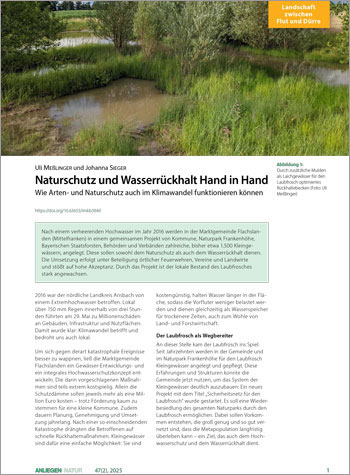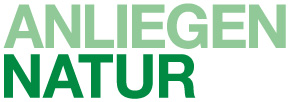Naturschutz und Wasserrückhalt Hand in Hand – Wie Arten- und Naturschutz auch im Klimawandel funktionieren können

Durch zusätzliche Mulden als Laichgewässer für den Laubfrosch optimiertes Rückhaltebecken (Foto: Uli Meßlinger)
Uli Meßlinger und Johanna Sieger
https://doi.org/10.63653/imkb3840
Nach einem verheerenden Hochwasser im Jahr 2016 werden in der Marktgemeinde Flachslanden (Mittelfranken) in einem gemeinsamen Projekt von Kommune, Naturpark Frankenhöhe, Bayerischen Staatsforsten, Behörden und Verbänden zahlreiche, bisher etwa 1.500 Kleingewässern, angelegt. Diese sollen sowohl dem Naturschutz als auch dem Wasserrückhalt dienen. Die Umsetzung erfolgt unter Beteiligung örtlicher Feuerwehren, Vereine und Landwirte und stößt auf hohe Akzeptanz. Durch das Projekt ist der lokale Bestand des Laubfrosches stark angewachsen.
Summary
Nature conservation and water retention go hand in hand – how species and nature conservation can work even in times of climate change
Following a devastating flood in 2016, a joint project involving the municipality, the Frankenhöhe Nature Park, the Bavarian State Forests, authorities, and associations in the municipality of Flachslanden (Middle Franconia) created numerous small ponds, currently approximately 1,500. These are intended to serve both nature conservation and water retention purposes. The project, which is being implemented with the participation of local fire departments, clubs, and farmers, has been met with high levels of acceptance. The project has led to a significant increase in the local tree frog population.
Zum Volltext-Download:
Anliegen Natur 47/2 (2025): 4 Seiten als Volltext herunterladen (pdf barrierefrei 0,7 MB).
 | 0
| 0 

Erst mal ein großes Lob an Uli Meßlinger als „Eingeborenen“ (und natürlich auch an Johanna Sieger) sowie an alle am Projekt Beteiligten in und um Flachslanden – SO gut geht’s und wirkt’s eben nur gemeinsam!
Um so trauriger ist es aber, wenn die Chefetage eines der Beteiligten die bewährten Erfolgspfade sperrt (bzw., um beim Thema zu bleiben, die Gewässer austrocknen lässt). Denn aktuell könnte ein Großteil der Maßnahmen gar nicht mehr umgesetzt werden; der Satz „Die stark gefährdete Zielart ermöglicht einen besonders hohen [LNPR-] Fördersatz“ gehört leider in die Vergangenheitsform gesetzt. Durch den plötzlichen Ausgabenstopp Ende letzten Jahres, die neuen Sparvorgaben u.a. für die LNPR-Gelder und die angekündigten Kürzungen für den Doppelhaushalt 2026/27 ist jetzt der viel gepriesene „bayerische Weg“ auf die Rote Liste gesetzt worden, Kategorie 2, mit Tendenz zu 1 …
Insofern – damit zumindest dieser Kommentar positiv endet – nochmal ein Lob an Uli, Johanna „et al.“: Sie waren nicht nur gut, sondern auch schnell genug!